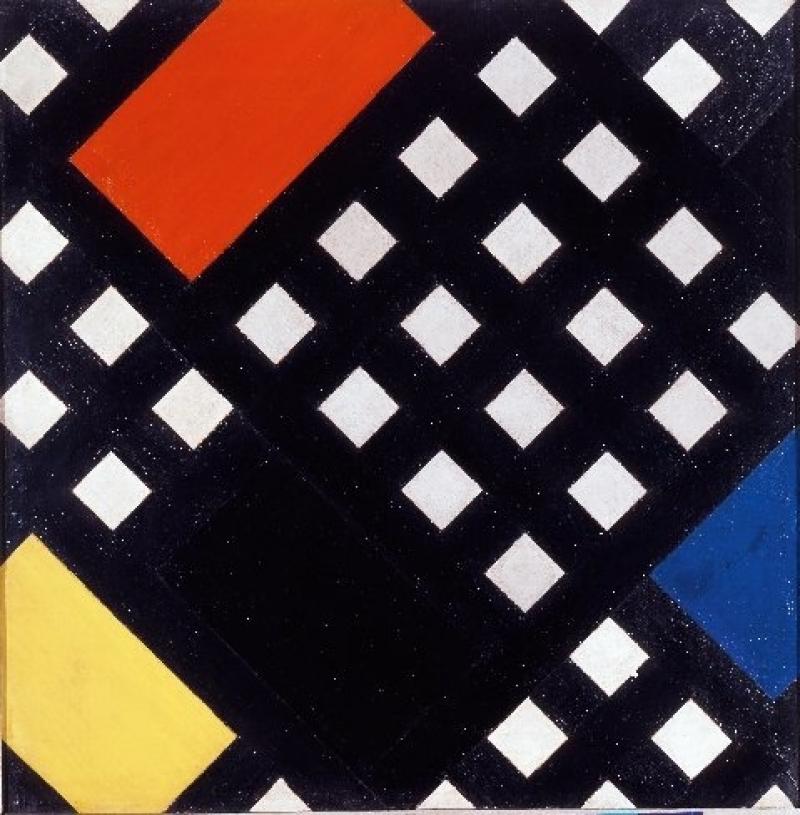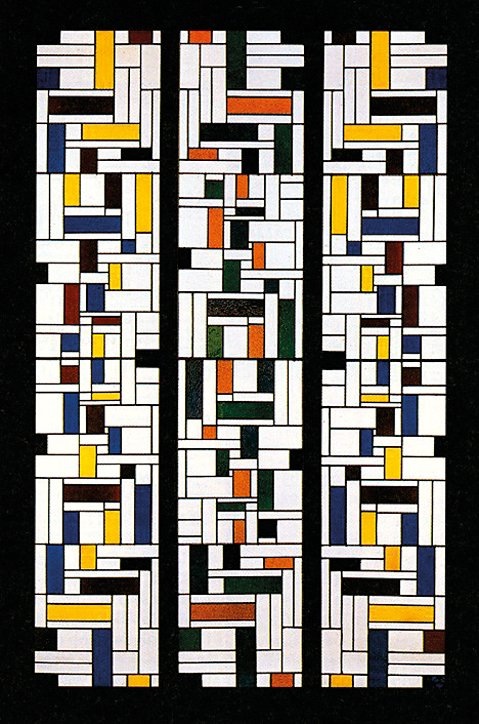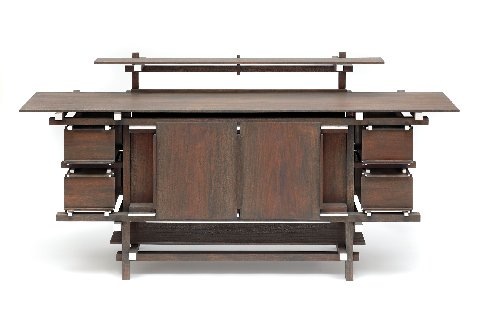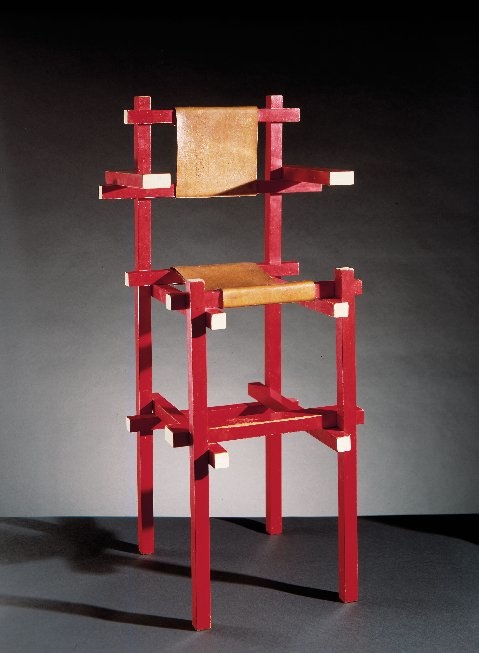Van Doesburg and the International Avant-Garde: Constructing a New World, Tate Modern | reviews, news & interviews
Van Doesburg and the International Avant-Garde: Constructing a New World, Tate Modern
Van Doesburg and the International Avant-Garde: Constructing a New World, Tate Modern
The future is square in Tate Modern's mammoth survey of Dutch movement

Modernist art movements are a lot like totalitarian regimes. They produce their declaratory manifestos, send forth their declamatory edicts, and, before you know it, a Year Zero mentality prevails: the past must be declared null and void.
Take, for instance, the great quarrel over the diagonal. In 1923, van Doesburg and Piet Mondrian fell out over it. Mondrian held firm that the future lay in horizontal and vertical lines, while van Doesburg insisted that, no, the diagonal must be permitted (actually, one feels that van Doesburg may have been a bit of an anarchist at heart, and straight lines and squares simply couldn’t contain him, since he also flirted with the Dadaists under the pseudonym I K Bonset.) Needless to say, this led to a complete severing of relations, the two only resuming contact six years later.
 Under the editorship of van Doesburg in 1917, De Stijl ("The Style") was founded initially as a journal, then as a fully fledged art movement. Painters, sculptors, designers and architects sought to unite their previously segregated art forms. So artists worked in practical design, designers in architectural practice, and painters in three dimensions. Designers including Gerrit Rietveld and architect J P Oud were soon inspired to join in. Moreover, it was a style that was to prove hugely influential to the Bauhaus, a movement that had previously adopted an English-inspired Arts and Crafts aesthetic. Still, you would never describe De Stijl as a homogenous movement: other artists whose aesthetic was quite removed from its strict geometry also featured, both in the journal and in the exhibitions van Doesburg organised.
Under the editorship of van Doesburg in 1917, De Stijl ("The Style") was founded initially as a journal, then as a fully fledged art movement. Painters, sculptors, designers and architects sought to unite their previously segregated art forms. So artists worked in practical design, designers in architectural practice, and painters in three dimensions. Designers including Gerrit Rietveld and architect J P Oud were soon inspired to join in. Moreover, it was a style that was to prove hugely influential to the Bauhaus, a movement that had previously adopted an English-inspired Arts and Crafts aesthetic. Still, you would never describe De Stijl as a homogenous movement: other artists whose aesthetic was quite removed from its strict geometry also featured, both in the journal and in the exhibitions van Doesburg organised.
Tate Modern’s mammoth survey of the movement is really quite a marvel, beautifully installed, intelligently curated and rich with historical detail. Its sweep is broad and rigorous, rather like the movement it celebrates. It encompasses not only the austere geometric paintings - the Compositions, Decompositions, Counter-Compositions and Simultaneous Counter-Compositions - of Doesburg, but his architectural designs, his new typography, his poetry and his stained glass windows (the latter are quite lovely, in fact - pictured above). These are shown alongside the canvases of Mondrian, and one begins to appreciate how much more varied van Doesburg’s activities were.
 Although you may occasionally feel disengaged by the repetitious imaginary - you are certain to leave with retinas imprinted with primary-coloured squares - there are plenty of pieces that will simply stop you in your tracks. Rietveld’s furniture designs, for example. If you ever imagine modernist design to be, well, a bit on the bland side, then take a look at Rietveld’s beautifully crafted Sideboard (pictured right). With its jutting and intersecting lines, there’s a lot going on in that sideboard; it’s kind of like a beautiful, rather complicated symphony, a symphony in sycamore brown, perhaps. (It’s not for nothing that abstract artists have often given their works the titles of musical forms.) But then again, I’m sure you'd find no use for Rietveld’s Child’s Highchair. (pictured below). Comfort and safety were not, it seems, necessary requirements of modernist design
Although you may occasionally feel disengaged by the repetitious imaginary - you are certain to leave with retinas imprinted with primary-coloured squares - there are plenty of pieces that will simply stop you in your tracks. Rietveld’s furniture designs, for example. If you ever imagine modernist design to be, well, a bit on the bland side, then take a look at Rietveld’s beautifully crafted Sideboard (pictured right). With its jutting and intersecting lines, there’s a lot going on in that sideboard; it’s kind of like a beautiful, rather complicated symphony, a symphony in sycamore brown, perhaps. (It’s not for nothing that abstract artists have often given their works the titles of musical forms.) But then again, I’m sure you'd find no use for Rietveld’s Child’s Highchair. (pictured below). Comfort and safety were not, it seems, necessary requirements of modernist design
 This labyrinthine exhibition reinstates van Doesburg to his rightful place. He was the driving force behind De Stijl, but unlike Mondrian he did not become a cult figure, nor even a remotely celebrated one. His name is largely forgotten. This is not because Mondrian was a better artist - I don't think he was, and excepting the direction of their lines, there is often little to distinguish their painterly styles. Rather, it is largely because Mondrian lived long enough to go off to New York just as that city was becoming the art centre of the universe. And, in turn, it was New York that inspired Mondrian’s wonderfully jazzy Boogie Woogie paintings. By then, van Doesburg had already been dead for nearly a decade, dying of a heart attack in his late 50s in 1931. And with him died the journal and movement he founded.
This labyrinthine exhibition reinstates van Doesburg to his rightful place. He was the driving force behind De Stijl, but unlike Mondrian he did not become a cult figure, nor even a remotely celebrated one. His name is largely forgotten. This is not because Mondrian was a better artist - I don't think he was, and excepting the direction of their lines, there is often little to distinguish their painterly styles. Rather, it is largely because Mondrian lived long enough to go off to New York just as that city was becoming the art centre of the universe. And, in turn, it was New York that inspired Mondrian’s wonderfully jazzy Boogie Woogie paintings. By then, van Doesburg had already been dead for nearly a decade, dying of a heart attack in his late 50s in 1931. And with him died the journal and movement he founded.
- Van Doesburg and the International Avant-Garde: Constructing a New World is at Tate Modern until 16 May
Share this article
more Visual arts
 Fantastic Machine review - photography's story from one camera to 45 billion
Love it or hate it, the photographic image has ensnared us all
Fantastic Machine review - photography's story from one camera to 45 billion
Love it or hate it, the photographic image has ensnared us all
 Yinka Shonibare: Suspended States, Serpentine Gallery review - pure delight
Weighty subject matter treated with the lightest of touch
Yinka Shonibare: Suspended States, Serpentine Gallery review - pure delight
Weighty subject matter treated with the lightest of touch
 Jane Harris: Ellipse, Frac Nouvelle-Aquitaine MÉCA, Bordeaux review - ovals to the fore
Persistence and conviction in the works of the late English painter
Jane Harris: Ellipse, Frac Nouvelle-Aquitaine MÉCA, Bordeaux review - ovals to the fore
Persistence and conviction in the works of the late English painter
 Sargent and Fashion, Tate Britain review - portraiture as a performance
London’s elite posing dressed up to the nines
Sargent and Fashion, Tate Britain review - portraiture as a performance
London’s elite posing dressed up to the nines
 Zineb Sedira: Dreams Have No Titles, Whitechapel Gallery review - a disorientating mix of fact and fiction
An exhibition that begs the question 'What and where is home?'
Zineb Sedira: Dreams Have No Titles, Whitechapel Gallery review - a disorientating mix of fact and fiction
An exhibition that begs the question 'What and where is home?'
 Yoko Ono: Music of the Mind, Tate Modern review - a fitting celebration of the early years
Acknowledgement as a major avant garde artist comes at 90
Yoko Ono: Music of the Mind, Tate Modern review - a fitting celebration of the early years
Acknowledgement as a major avant garde artist comes at 90
 Unravel: The Power and Politics of Textiles in Art, Barbican review - the fabric of dissent
An ambitious exploration of a neglected medium
Unravel: The Power and Politics of Textiles in Art, Barbican review - the fabric of dissent
An ambitious exploration of a neglected medium
 When Forms Come Alive, Hayward Gallery review - how to reduce good art to family fun
Seriously good sculptures presented as little more than playthings or jokes
When Forms Come Alive, Hayward Gallery review - how to reduce good art to family fun
Seriously good sculptures presented as little more than playthings or jokes
 Entangled Pasts 1768-now, Royal Academy review - an institution exploring its racist past
After a long, slow journey from invisibility to agency, black people finally get a look in
Entangled Pasts 1768-now, Royal Academy review - an institution exploring its racist past
After a long, slow journey from invisibility to agency, black people finally get a look in
 Barbara Kruger, Serpentine Gallery review - clever, funny and chilling installations
Exploring the lies, deceptions and hyperbole used to cajole, bully and manipulate us
Barbara Kruger, Serpentine Gallery review - clever, funny and chilling installations
Exploring the lies, deceptions and hyperbole used to cajole, bully and manipulate us
 Richard Dorment: Warhol After Warhol review - beyond criticism
A venerable art critic reflects on the darkest hearts of our aesthetic market
Richard Dorment: Warhol After Warhol review - beyond criticism
A venerable art critic reflects on the darkest hearts of our aesthetic market
 Dineo Seshee Raisibe Bopape: (ka) pheko ye / the dream to come, Kiasma, Helsinki review - psychic archaeology
The South African artist evokes the Finnish landscape in a multisensory installation
Dineo Seshee Raisibe Bopape: (ka) pheko ye / the dream to come, Kiasma, Helsinki review - psychic archaeology
The South African artist evokes the Finnish landscape in a multisensory installation

Add comment